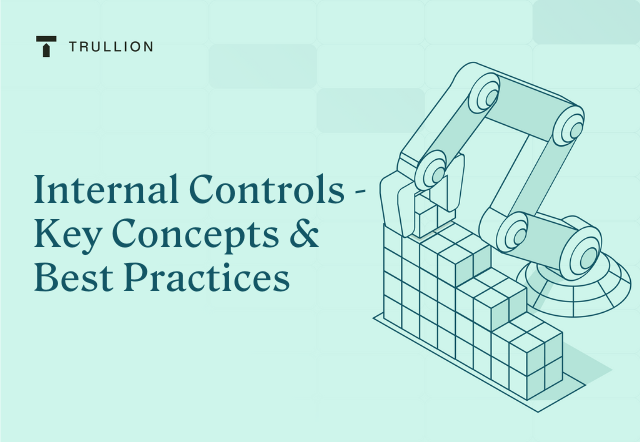At the heart of every efficient organization are effective internal controls that provide the necessary checks and balances to ensure that correct processes are followed, the risk of fraud is minimized, a transparent audit trail exists, and a sense of confidence is provided to all stakeholders.
We’ll look into the key components of internal controls, including best practices and internal controls examples. We’ll also discover some of the most exciting developments in this space, particularly regarding how technology is reshaping the implementation and management of internal controls – ultimately empowering accountants and auditors to provide maximum value to stakeholders while minimizing the risk and manual effort required.
Understanding Internal Controls
In refreshing our knowledge – in terms of understanding what internal controls are, accounting professionals can start with the objectives of strong internal controls.
Internal controls play a crucial role in safeguarding companies’ assets, preventing financial mismanagement as well as errors, and promoting compliance with regulatory requirements.
Objectives and Benefits of Strong Internal Control Systems
A robust internal control system serves multiple objectives, all of which contribute to the efficient and ethical functioning of a business. These objectives include:
Ensuring accuracy and completeness: By systematically verifying transactions and reconciling accounts, these controls minimize the risk of erroneous financial information being presented to stakeholders, thus enhancing the credibility of the organization.
Safeguarding assets from misappropriation or theft: Through mechanisms such as segregation of duties and authorization procedures, strong internal controls create a system of accountability and deter potential fraudulent activities.
Establishing compliance with laws and regulations: By implementing processes that ensure adherence to legal requirements, organizations avoid penalties, reputational damage, and potential legal liabilities.
Optimizing operational efficiency: By standardizing procedures and reducing the likelihood of errors, these controls streamline processes and improve the overall effectiveness of business operations.
Promoting informed decision-making: Accurate and reliable financial information enables management to make well-informed strategic choices, allocate resources effectively, and identify areas for improvement.
Key Principles of Internal Controls
The control environment represents the foundation upon which effective internal controls are built. It encompasses the ethical values, integrity, and commitment to compliance demonstrated by an organization’s leadership.
A strong control environment not only sets the tone for ethical behavior but also encourages employees to embrace their responsibilities in safeguarding assets and maintaining accurate financial records.
Risk Assessment: Identifying and Evaluating Risks
Effective internal controls require a comprehensive understanding of potential risks that could impact an organization’s financial integrity. Risk assessment involves systematically identifying, analyzing, and prioritizing these risks. By assessing both internal and external factors, organizations can proactively address vulnerabilities and develop strategies to mitigate or manage risks.
Control Activities: Designing and Implementing Preventive Measures
Control activities are the tangible steps taken to ensure that established internal control objectives are achieved. They encompass a range of practices, such as segregation of duties, authorization procedures, documentation of transactions, and periodic reconciliations. Properly designed control activities serve as the building blocks of a resilient internal control system, enhancing the accuracy and reliability of financial information.
CFO’s Role in Internal Controls
The CFO is typically the central professional when it comes to designing, implementing, and testing internal controls.
Leadership in Risk Management and Compliance
The CFO should be equipped with a comprehensive understanding of the organization’s risk landscape and the ability to prioritize and address potential vulnerabilities. By proactively implementing control measures to mitigate risks, the CFO safeguards the company’s financial integrity and protects stakeholders’ interests.
Collaboration with Other Stakeholders
Effective internal control implementation requires collaboration and coordination across various departments and levels of the organization. The CFO serves as a bridge between financial operations and other functional areas, fostering communication and cooperation. This collaborative approach enhances the effectiveness of internal controls by addressing potential gaps and ensuring consistent adherence to control procedures.
Types of Internal Controls
There are several types of internal controls, each with specific objectives. The types of internal controls include:
Preventive Controls: These controls are designed to stop errors, fraud, or unauthorized activities from occurring in the first place. They establish barriers and protocols to prevent risks and ensure compliance. Examples include segregation of duties, access controls, approval workflows, and proper documentation.
Detective Controls: Detective controls are focused on identifying anomalies, errors, or potential issues that may have bypassed preventive measures. They monitor and detect irregularities in financial transactions or operational processes. Examples include regular reconciliations, exception reports, data analysis, and audit trails.
Corrective Controls: These controls come into play after an issue has been identified through preventive or detective controls. Corrective actions may involve process improvements, employee training, system enhancements, or policy revisions.
Directive Controls: Directive controls provide clear guidance and direction to employees on how to perform their tasks accurately and in accordance with established policies and procedures. They include written instructions, manuals, guidelines, and training programs.
Compensating Controls: Compensating controls are put in place to mitigate risks when a primary control is not feasible or effective. For example, if segregation of duties is not possible due to a small staff, compensating controls like managerial review may be implemented.
IT Controls: Information technology controls ensure the security, integrity, and availability of an organization’s technology infrastructure and data. These controls include access controls, encryption, firewalls, intrusion detection systems, and regular IT audits.
Monitoring Controls: Monitoring controls involve ongoing assessment and review of other internal controls to ensure they are operating effectively. Regular audits, reviews, and evaluations are part of monitoring controls.
Authorization Controls: Authorization controls require appropriate approvals or permissions before certain transactions or activities can take place. They help prevent unauthorized actions and ensure accountability.
Physical Controls: Physical controls protect tangible assets such as cash, inventory, and equipment. Examples include locks, security cameras, access badges, and physical segregation of valuable items.
Segregation of Duties: This control involves distributing tasks and responsibilities among different individuals to prevent any one person from having complete control over a critical process.
Documentation Controls: Proper documentation of transactions, processes, and activities is essential for transparency, accountability, and audit trail purposes. Documentation controls include maintaining records, logs, and supporting documentation for transactions.
Training and Education Controls: These controls ensure that employees are adequately trained and educated about the organization’s policies, procedures, and ethical standards. Well-informed employees are less likely to make errors or engage in fraudulent activities.
These provide something of an accounting internal controls checklist that can be used to select the most appropriate internal controls for your business processes.
Key Components of Internal Controls
After outlining the different types of controls available, let’s go further and deepen our understanding of the key components underpinning some of them:
Segregation of Duties: Ensuring Checks and Balances
As referenced previously, the segregation of duties is a fundamental component of internal controls that aims to prevent errors and fraud by dividing critical tasks among different individuals. By separating responsibilities such as authorization, execution, and review, organizations reduce the risk of errors going undetected and discourage fraudulent activities.
Authorization and Approval Processes: Establishing Accountability
Authorization and approval processes are essential to maintain accountability and ensure that transactions or actions are carried out within established guidelines. These processes involve obtaining appropriate permissions and sign-offs before specific activities are undertaken. By enforcing a hierarchical system of approvals, organizations prevent unauthorized or inappropriate actions, promote adherence to policies, and establish a clear chain of responsibility.
Documentation and Record-Keeping: Maintaining Reliable Audit Trails
Accurate documentation and record-keeping are integral to internal controls as they create a reliable audit trail of transactions and activities. Proper documentation provides evidence of the occurrence and legitimacy of business events, making it easier to track and verify processes.
Assessing and Testing Internal Controls
Of course, for internal controls to be effective they have to be continually assessed and tested, both internally, and by external auditors.
Internal Control Assessments and Evaluations
Regular assessments and evaluations of internal controls are crucial to ensuring their effectiveness in safeguarding assets and achieving organizational objectives. Internal control assessments involve a systematic review of the design and operation of control activities. Evaluations consider factors such as the control environment, risk management processes, and the reliability of financial reporting. These assessments help identify gaps, weaknesses, and opportunities for improvement in the internal control framework.
Risk-Based Approach to Internal Control Testing
A risk-based approach is a cornerstone of effective internal control testing. This method involves prioritizing control testing efforts based on the level of risk associated with specific processes or transactions. By focusing resources where risks are greatest, organizations can allocate their efforts efficiently and effectively to address vulnerabilities that could have the most significant impact on the achievement of objectives.
Methods and Techniques for Evaluating Control Effectiveness
Several methods and techniques are employed to evaluate the effectiveness of internal controls:
- Testing of Controls: This involves performing tests to determine whether control activities are functioning as designed. Samples of transactions are reviewed to ensure compliance with established procedures.
- Walkthroughs: Walkthroughs involve tracing a transaction from its initiation to its completion to assess the effectiveness of controls at each stage. This helps identify control gaps and areas where improvements are needed.
- Data Analysis: Data analytics tools are used to examine large datasets for patterns, anomalies, and irregularities. These insights can uncover control weaknesses or areas of concern.
- Reconciliation and Review: Regular reconciliations and reviews of accounts, documents, and reports can identify discrepancies and errors that may indicate control deficiencies.
- Control Self-Assessment: This involves engaging employees in assessing the effectiveness of controls within their respective areas. It fosters a culture of accountability and empowers staff to contribute to control improvement.
- Benchmarking: Benchmarking involves comparing an organization’s internal controls against industry best practices or recognized standards to identify gaps and areas for enhancement.
Internal Controls in Regulatory Compliance
There are a number of facets to internal controls and how they interface with regulatory compliance requirements.
Compliance with Laws and Regulations
By establishing control procedures that align with legal requirements, organizations can minimize the risk of non-compliance and potential legal liabilities. For instance, controls can be implemented to verify that financial transactions adhere to tax regulations, environmental laws, data privacy regulations, and other relevant statutes.
Financial Reporting and Audit Requirements
Internal controls are essential for accurate and reliable financial reporting. By maintaining proper documentation, conducting regular reconciliations, and implementing approval processes, organizations create a solid foundation for financial reporting that stands up to external audits and scrutiny.
Role of Internal Controls in Preventing Fraud and Misconduct
Internal controls serve as a frontline defense against fraud, misconduct, and unethical behavior. Controls such as segregation of duties, authorization processes, and periodic reconciliations help identify irregularities and anomalies, enabling timely intervention and investigation. Furthermore, a robust internal control environment promotes an ethical culture and emphasizes the organization’s commitment to integrity and accountability.
Whistleblower Mechanisms and Reporting
Internal controls can include mechanisms for reporting and addressing potential wrongdoing. Whistleblower hotlines or confidential reporting channels allow employees to report concerns or suspicions of fraud, misconduct, or non-compliance without fear of retaliation. These reporting mechanisms encourage transparency and provide an avenue for addressing issues before they escalate.
Technology and Automation in Internal Controls
One of the areas in accounting and audit that can most benefit from advances in technology – and particularly automation – is internal controls.
Role of Technology in Enhancing Internal Control Processes
The integration of technology and automation has revolutionized the landscape of internal controls, significantly enhancing their effectiveness and efficiency. Advanced technologies, such as AI-powered automated accounting software, play a pivotal role in streamlining control activities, improving accuracy, and mitigating risks. These technologies enable organizations to move beyond manual processes and embrace a more agile and proactive approach to internal controls.
Automated Control Monitoring
One of the notable advancements facilitated by technology is automated control monitoring. AI-powered software can monitor transactions, data inputs, and processes in real time, flagging anomalies and deviations from established control parameters. This proactive monitoring allows organizations to promptly identify and address potential control breaches, reducing the time lag between occurrence and detection.
Benefits of Technology Adoption in Internal Controls
Benefits include:
- Efficiency: Technology automates repetitive tasks and data analysis, freeing up resources and enabling employees to focus on higher-value activities.
- Accuracy: Automated systems reduce the likelihood of human errors and inconsistencies, ensuring that control activities are executed consistently and reliably.
- Timeliness: Real-time monitoring and alerts enable swift responses to control breaches, minimizing potential negative impacts.
- Scalability: Technology allows controls to be applied consistently across large volumes of transactions and processes.
- Data Insights: AI-powered tools can analyze massive amounts of data, and offer valuable insights into control performance, trends, and areas for improvement.
Challenges of Technology Adoption in Internal Controls
Of course, like any area of technology, there are challenges too.
- Implementation Complexity: Integrating technology into existing control processes may require significant time and effort, including system setup, customization, and employee training.
- Data Quality: Technology-driven controls heavily rely on accurate and consistent data. Poor data quality can lead to false positives or negatives, undermining control effectiveness.
- Resource Requirements: Adopting and maintaining technology solutions may necessitate financial investment, skilled personnel, and ongoing support.
- Change Management: Employees may resist or struggle to adapt to new technologies, requiring a comprehensive change management strategy.
Incorporating AI-powered automated accounting software specifically into internal control processes empowers organizations to enhance monitoring, reporting, and analysis capabilities, and mitigates the challenges faced when it comes to integrating technology and internal control management.
While challenges exist, the benefits of technology adoption in internal controls far outweigh the drawbacks, enabling businesses to navigate risks, comply with regulations, and achieve operational excellence in an increasingly complex and dynamic business environment.
Internal Controls Best Practices
A robust control environment starts with a leadership commitment to ethical behavior, transparency, and accountability. It sets the tone for a culture where employees understand the importance of internal controls. Management should clearly communicate expectations, establish codes of conduct, and provide adequate training.
Ongoing Monitoring
Internal controls should not be treated as static processes. Regular monitoring is essential to ensure that controls remain effective and relevant. This involves periodic assessments, reviews, and testing of control activities. By continuously monitoring control performance, organizations can identify weaknesses, address emerging risks, and make informed decisions to enhance their control framework.
Continuous Improvement and Adaptation to Changing Risks
Internal controls must evolve alongside an organization’s changing risk landscape. As new risks emerge or business processes evolve, control activities should be adapted accordingly. Regular risk assessments help organizations identify emerging threats and adjust their controls to address these challenges. A culture of continuous improvement encourages proactive responses to risks and promotes the agility needed to stay ahead of potential issues.
How Trullion Can Help
Trullion is an accounting oversight platform that leverages AI to simplify workflows. It’s used by accounting, audit, and advisory teams to reduce risk and manual work and increase accuracy, insights, and compliance.
Thanks to AI-provided automation and extraction, the effectiveness of internal controls can be ascertained at a glance, and full audit-ready reports can be generated to satisfy all stakeholders.
Transparent audit trails mean that both internal and external teams can monitor activities for anomalies, any compliance issues can be surfaced in real-time, and powerful insights can be presented that add value to the finance teams in particular, and the organization as a whole in general.
For example, Trullion client Bradken gives their auditor access to the Trullion platform. “If they want to look at a contract, they can go in and help themselves rather than us having to pluck out contracts. Even just showing them how the schedules are built, the accounting entries and things like that – they can know how to look themselves. Then if they’ve got any questions, just come straight back to us,” says Morgan Hoffmann, the Group Financial Accountant.
Internal Controls: The Foundation For An Efficient Organization
We saw how critical internal controls are for a high-performance company. With these in place, working effectively, and tested often, finance and audit teams – and other stakeholders – can be confident in the financial information being reported by the organization.
Specifically, we looked into the key principles of internal controls, how to assess and monitor internal controls, different internal control types, the CFO’s role in this space, as well as how technology and automation are allowing us to reimagine the future of effective internal controls.
For companies, finance teams, CFOs, audit firms, and consulting organizations, implementing Trullion can bring your internal controls environment into the 21st century.
Learn more by setting up a call with a Trullion product expert today.










